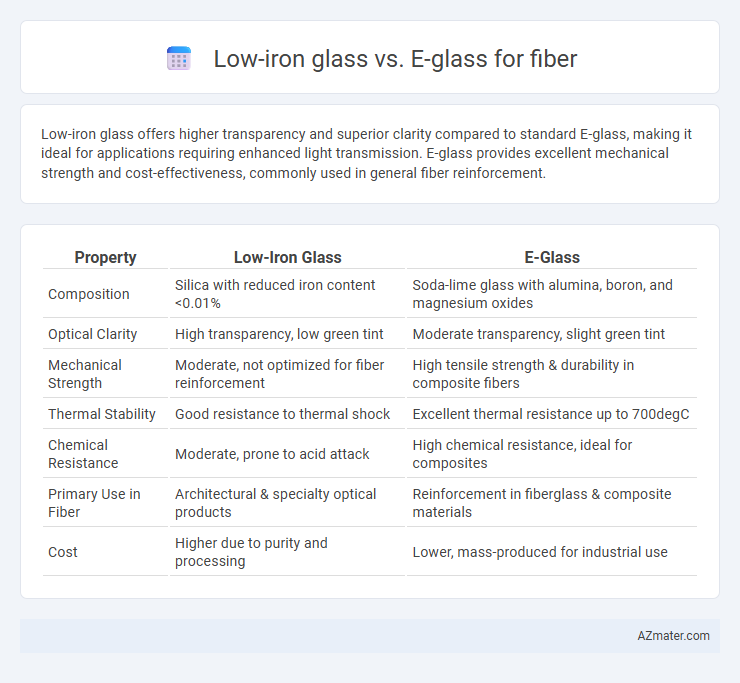Low-iron glass offers higher transparency and superior clarity compared to standard E-glass, making it ideal for applications requiring enhanced light transmission. E-glass provides excellent mechanical strength and cost-effectiveness, commonly used in general fiber reinforcement.
Table of Comparison
| Property | Low-Iron Glass | E-Glass |
|---|---|---|
| Composition | Silica with reduced iron content <0.01% | Soda-lime glass with alumina, boron, and magnesium oxides |
| Optical Clarity | High transparency, low green tint | Moderate transparency, slight green tint |
| Mechanical Strength | Moderate, not optimized for fiber reinforcement | High tensile strength & durability in composite fibers |
| Thermal Stability | Good resistance to thermal shock | Excellent thermal resistance up to 700degC |
| Chemical Resistance | Moderate, prone to acid attack | High chemical resistance, ideal for composites |
| Primary Use in Fiber | Architectural & specialty optical products | Reinforcement in fiberglass & composite materials |
| Cost | Higher due to purity and processing | Lower, mass-produced for industrial use |
Introduction to Low-Iron Glass and E-Glass
Low-iron glass is characterized by its high silica content and reduced iron oxide, which enhances light transmission and clarity, making it ideal for high-visibility fiber optic applications. E-glass, or electrical-grade glass, contains higher iron content but offers excellent mechanical strength and chemical resistance, commonly used in fiber reinforcement and composites. The choice between low-iron glass and E-glass depends on the balance between optical clarity and structural durability required in fiber technology.
Chemical Composition Differences
Low-iron glass contains reduced amounts of iron oxide (Fe2O3), typically less than 0.03%, enhancing its optical clarity and reducing greenish tint in fiber applications, whereas E-glass has higher iron content around 0.5-1.0%, contributing to slightly lower transparency. The primary chemical difference lies in the significantly lower iron impurities in low-iron glass, which improves light transmission and makes it ideal for high-performance optical fibers. E-glass, composed mainly of silica (SiO2), alumina (Al2O3), and calcium oxide (CaO), has a balanced composition for mechanical strength but less optimized for optical clarity compared to low-iron glass.
Optical Clarity and Light Transmission
Low-iron glass offers superior optical clarity and higher light transmission compared to standard E-glass, making it ideal for applications requiring enhanced visibility and minimal color distortion. E-glass fibers provide good strength and corrosion resistance but have a higher iron content that slightly reduces light transmission and clarity. Choosing low-iron glass fiber ensures maximum light throughput and clarity, critical for precision optics and solar energy devices.
Mechanical Strength and Durability
Low-iron glass fibers exhibit higher mechanical strength and improved durability compared to E-glass fibers, due to their reduced iron oxide content which minimizes impurities and enhances fiber integrity. E-glass, commonly used in reinforced plastics, offers good mechanical strength but lower corrosion resistance and durability under harsh environmental conditions. The superior tensile strength and resistance to chemical degradation make low-iron glass fibers more suitable for demanding structural applications requiring long-term performance.
Performance in Fiber Applications
Low-iron glass offers superior optical clarity and sunlight transmission, making it ideal for fiber applications requiring enhanced light performance and minimal signal loss. E-glass, known for its high tensile strength and cost-effectiveness, provides excellent mechanical durability but with slightly higher impurities that can affect optical quality. Selecting between low-iron glass and E-glass depends on prioritizing optical performance versus mechanical robustness in fiber optics.
Thermal and Electrical Properties
Low-iron glass offers superior thermal stability and lower thermal expansion compared to standard E-glass, making it ideal for high-temperature fiber applications. Its enhanced electrical insulation properties result from reduced iron content, which minimizes conductivity and dielectric loss. E-glass, while more cost-effective, exhibits higher electrical conductivity and slightly lower thermal resistance, limiting its use in extreme thermal or electrical environments.
Impact on Fiber Quality and Purity
Low-iron glass significantly enhances fiber quality and purity by reducing the presence of iron oxides, which can cause discoloration and weaken the mechanical properties of fibers. E-glass, while widely used for its durability and cost-effectiveness, contains higher iron content that may introduce impurities and affect the optical clarity of the final fiber product. Using low-iron glass results in superior fiber performance with increased strength, improved transparency, and greater resistance to corrosion, essential for high-precision applications.
Cost Comparison and Availability
Low-iron glass typically costs more than E-glass due to its higher purity and enhanced optical clarity, making it less accessible for large-scale fiber production. E-glass remains the industry standard, offering a balance of low cost and widespread availability, which is critical for mass manufacturing of fiberglass products. Supply chain stability favors E-glass, as its raw materials and production processes are well-established globally, reducing lead times and price volatility compared to low-iron glass fiber.
Environmental Considerations
Low-iron glass fibers offer enhanced clarity and are often preferred for applications requiring high light transmission, but their production involves higher energy consumption and raw material refinement compared to E-glass fibers. E-glass fibers, widely used in environmental composites, provide a balanced combination of mechanical strength and cost-efficiency while typically generating lower environmental impact during manufacturing. Sustainable practices in fiber production increasingly emphasize recyclability and reduced carbon footprint, making the choice between low-iron glass and E-glass critical for eco-conscious design and performance goals.
Choosing the Right Glass for Fiber Production
Low-iron glass offers superior clarity and light transmission, making it ideal for high-performance fiber applications requiring minimal signal loss and enhanced optical properties. E-glass, primarily composed of alumino-borosilicate, provides excellent mechanical strength and electrical insulation at a lower cost, suitable for general-purpose fiber reinforcement. Selecting between low-iron glass and E-glass depends on balancing optical clarity needs against structural requirements and budget constraints for fiber production.

Infographic: Low-iron glass vs E-glass for Fiber
 azmater.com
azmater.com